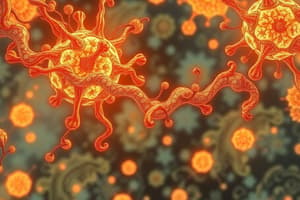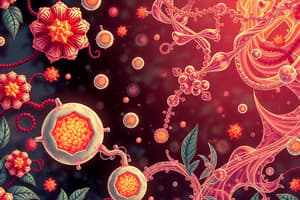Podcast
Questions and Answers
Which enzyme activates pancreatic trypsin in the duodenum?
Which enzyme activates pancreatic trypsin in the duodenum?
- Erepsin
- Maltase
- Lipase
- Enterokinase (correct)
What are the products of protein digestion in the duodenum?
What are the products of protein digestion in the duodenum?
- Sucrose and fructose
- Peptides and amino acids (correct)
- Maltose and glucose
- Fatty acids and glycerol
What is the primary carbohydrate broken down in the duodenum?
What is the primary carbohydrate broken down in the duodenum?
- Maltose (correct)
- Cellulose
- Glucose
- Lactose
What substances are produced from fats during the digestion process in the duodenum?
What substances are produced from fats during the digestion process in the duodenum?
What is the main function of the colon in the digestive system?
What is the main function of the colon in the digestive system?
What is the primary function of the large intestine?
What is the primary function of the large intestine?
Which statement about the caecum and appendix in humans is accurate?
Which statement about the caecum and appendix in humans is accurate?
What happens to glucose after it is absorbed in the blood?
What happens to glucose after it is absorbed in the blood?
What is the role of bacteria in the large intestine?
What is the role of bacteria in the large intestine?
How are fats absorbed after digestion?
How are fats absorbed after digestion?
What best describes the process of assimilation?
What best describes the process of assimilation?
Which type of food component is primarily processed in the caecum of herbivores?
Which type of food component is primarily processed in the caecum of herbivores?
What role does the hepatic portal vein play in digestion?
What role does the hepatic portal vein play in digestion?
What is the primary role of trypsin in digestion?
What is the primary role of trypsin in digestion?
Which enzyme is responsible for the breakdown of starch?
Which enzyme is responsible for the breakdown of starch?
Why is the ileum particularly efficient at absorbing digested nutrients?
Why is the ileum particularly efficient at absorbing digested nutrients?
What is the function of bile in digestion?
What is the function of bile in digestion?
Which of the following components is NOT found in bile?
Which of the following components is NOT found in bile?
How does sodium hydrogen carbonate function in the small intestine?
How does sodium hydrogen carbonate function in the small intestine?
In which part of the digestive system does protein digestion primarily begin?
In which part of the digestive system does protein digestion primarily begin?
What is the primary nutrient absorbed in the ileum?
What is the primary nutrient absorbed in the ileum?
Flashcards
Duodenum's Role in Digestion
Duodenum's Role in Digestion
The duodenum is where the majority of chemical digestion takes place, partly aided by pancreatic enzymes and intestinal juices.
Ileum's Function
Ileum's Function
The ileum is primarily responsible for absorbing the digested nutrients.
Pancreatic Enzymes
Pancreatic Enzymes
Pancreatic enzymes help break down fats, proteins, and carbohydrates into smaller molecules.
Digestion in the Ileum
Digestion in the Ileum
Signup and view all the flashcards
Colon role in Digestion
Colon role in Digestion
Signup and view all the flashcards
Hepatic Portal Vein
Hepatic Portal Vein
Signup and view all the flashcards
Glycogen Storage
Glycogen Storage
Signup and view all the flashcards
Lacteals
Lacteals
Signup and view all the flashcards
Large Intestine Function
Large Intestine Function
Signup and view all the flashcards
Bacterial Digestion in Colon
Bacterial Digestion in Colon
Signup and view all the flashcards
Assimilation
Assimilation
Signup and view all the flashcards
Digestive Juices Amount
Digestive Juices Amount
Signup and view all the flashcards
Defecation
Defecation
Signup and view all the flashcards
Small Intestine Parts
Small Intestine Parts
Signup and view all the flashcards
Ileum Absorption
Ileum Absorption
Signup and view all the flashcards
Large Absorbing Surface
Large Absorbing Surface
Signup and view all the flashcards
Villi Structure
Villi Structure
Signup and view all the flashcards
Pancreatic Juice Function
Pancreatic Juice Function
Signup and view all the flashcards
Pancreatic Juice pH Neutralization
Pancreatic Juice pH Neutralization
Signup and view all the flashcards
Bile Secretion
Bile Secretion
Signup and view all the flashcards
Enzyme Action in Ileum
Enzyme Action in Ileum
Signup and view all the flashcards
Study Notes
Enzymes and Digestion
- Enzymes are proteins that speed up chemical reactions
- Enzymes are biological catalysts
- Enzymes are not used up in the reaction
- Enzymes are specific to their substrates
- The substrate fits into the active site of the enzyme, similar to a lock and key
- Enzymes work best at an optimal temperature and pH
- High temperatures can denature enzymes, making them ineffective
- Enzymes work best at body temperature (36-38°C)
- The optimal pH varies for different enzymes
- The rate of enzyme activity depends on factors including concentration of substrate, enzyme, and surface area
Chemical and Biological Nature of Enzymes
- Enzymes are made of proteins
- Proteins contain elements C, N, O, and H
- The monomers of proteins are amino acids
- Amino acids have an amino group, a carboxyl group, and a variable R-group.
Factors Affecting Enzymes
- Enzyme function is affected by temperature and pH
- Higher temperatures (below 40°C) increase enzyme activity
- Temperatures above 40°C denature enzymes, decreasing their activity
- Too low temperatures decrease enzyme activity
- Different enzymes have different optimal temperatures and pH values
- Surface area and concentration of enzymes affect the rate of reaction
pH
- The optimal pH is different for different enzymes
- Pepsin (stomach enzyme) works best at a pH of 2
- Catalase (found in all cells) does best between pH 4-11
Enzymes are Substrate Specific
- Enzymes are highly specific to their substrates
- Substrates bind to the active site of the enzyme
- This is called the 'induced fit' theory
- The substrate is changed to a different substance which is called a product
- Enzymes can either build up (anabolism) or else break down (catabolism) a substance
Economic Importance of Enzymes
- Enzymes are used in various industries
- Rennin is used to coagulate milk for cheese production
- Cellulase and amylase to remove waxes, oils, and starches from fabrics
- Amylase, protease, lipases, oxidases and cellulases are used in detergents
Holozoic Nutrition
- This is the method of obtaining organic food from other living organisms
- This is how animals obtain nutrients
- The food is digested
- The soluble products are absorbed into the bloodstream
- Indigestible waste is eliminated
Saprophytic Nutrition
- This is the method of obtaining food by decomposing organic matter
- This is how bacteria and fungi obtain nutrients
- They digest organic matter with their secreted enzymes.
- The soluble products are absorbed
Holophytic Nutrition
- This type of nutrition is specific to green plants
- They make their organic food by photosynthesis
- Combining carbon dioxide and water
Holozoic Nutrition in Animals
- Includes ingestion, digestion, absorption, and egestion of food
- Details of structure are given and functions of a few major structures
Ingestion
- The process of taking food into the mouth
- Incisors are used to cut food, canine to tear it apart
- Pre-molars and molars crush and chew the food
- Buccal cavity contains the tongue and teeth inside the mouth
- The pharynx is the throat
- Oesophagus is the food pipe
- Swallowing action is required for moving food down the oesophagus through the pharynx and into the stomach
Digestion in the stomach
- The stomach has elastic walls
- The stomach prepares food for assimilation, the process of transferring molecules into the cells.
- The stomach digests food using pepsin and hydrochloric acid
- A churning effect mixes food with pepsin and hydrochloric acid
- Storage occurs in the stomach before sending food through the rest of the digestive system.
Digestion in the duodenum and the ileum
- Enzymes are produced in the pancreas and liver and released into the duodenum
- Enzymes such as trypsin, amylase and lipase are used to break down proteins, carbohydrates and fats.
- Bile is produced in the liver and stored in the gall bladder, and is released into the duodenum
- Bile suspends fats which allows for easier digestion.
- Further digestion in the ileum is done with enzymes such as maltase, sucrase and lactase to convert carbohydrate into glucose
- Amino acids, glucose, glycerol and fatty acids pass through the villi
Use of digested food
- The blood transports the digested foods around the body
- Assimilation of food occurs in cells
- Glucose is either used immediately or stored as glycogen in the liver or muscles.
- Excess glucose can be stored in fat depots
- Fats are used in cell structures
- Protein is made from amino acids, used in metabolism or stored.
Studying That Suits You
Use AI to generate personalized quizzes and flashcards to suit your learning preferences.



